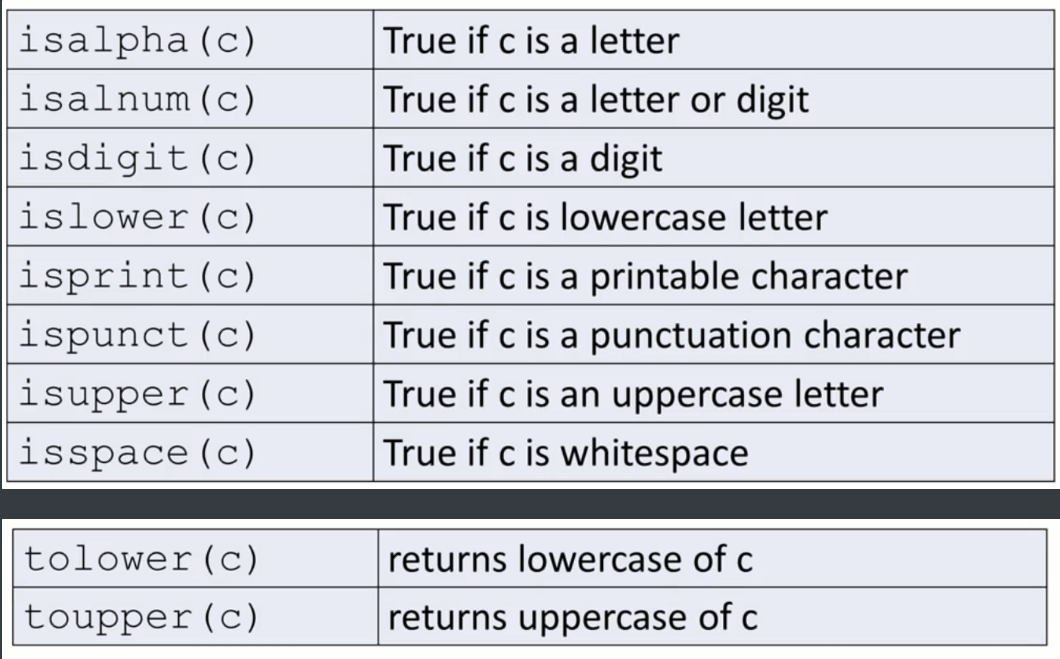字符串
C++ 提供了以下两种类型的字符串表示形式:
-
C 风格字符串
-
C风格字符串
int main(){ char greeting[6] = {'H', 'e', 'l', 'l', 'o', '�'}; //可以简写成: char greeting2[] = "Hello"; return 0 ; }
c风格字符串常见操作
1.遍历字符串
#include<iostream> int main(){ //最后总会跟着一个�的空字符,此时括号中如果写长度,必须大于等于6 char name[] = "hello"; for (int i = 0; i < sizeof(name ) / sizeof(char); ++i) { std::cout << name[i] << std::endl; } }
2.字符串的其他操作
以下函数的使用,需要引入 #include<ctype.h>

拷贝、拼接字符串
#include <iostream> int main(){ //拷贝字符串 char name[] = "hello"; char name2[6]; //参数一: 目标字符串, 参数二:源字符串 strcpy(name2 , name); std::cout << name2 << std::endl; //拼接字符串 strcat(name2 , " , 张三"); std::cout << name2 << std::endl; // 返回字符串长度 int len = strlen(name2); std::cout << "name2的长度:" << len << std::endl; return 0 ; }
#include <iostream>
//必须引入string库 #include <string> using namespace std; int mian(){ string s1; string s2 {"北京"}; string s3{s2}; string s4 = "你好"; s1 = s3; return 0 ; }
1.拼接字符串
c++字符串的拼接跟Python一样,直接用+拼接即可。
#include <iostream> #include<string> using namespace std; int main(){ string part1 {"c++"}; string part2 {" is a powerful"}; string sentence ; sentence = part1 + part2 ; cout << sentence << endl; // 结果是 c++ is a powerful return 0 ; }
2.获取指定位置的字符
可以使用[]和 at()操作字符串
#include <iostream> #include<string> using namespace std; int main(){ string s1 {"i love c++"}; cout << s1[3]<<endl; // o cout << s1.at(0) << endl; // i return 0 ; }
3.遍历字符串
#include <iostream> #include<string> using namespace std; int main(){ string s1 {"abcdef"}; for(char s : s1){ cout << s << " "; // 打印的结果 :a b c d e f } cout << endl; for(int s : s1){ // 因为s1是字符串类型,指定的s又为int类型,所以这里面打印出来是字符所对应的ascii码 cout << s << " "; // 打印的结果:97 98 99 100 101 102 } cout << endl; return 0 ; }
4.字符串比较
字符串也是可以比较大小的。
#include <iostream> #include<string> using namespace std; int main(){ string s1{"Apple"}; string s2{"Banana"}; string s3 {"kiwi"}; string s3 {"apple"}; string s3 {s1}; s1 == s5 // true s1 == s2 // false s1 != s2 // true s1 < s2 // True s1 > s2 // false s1 == "Apple" // false return 0 ; }
5.截取字符串
#include <iostream> #include<string> using namespace std; int main(){ substr(开始索引, 截取长度); string s1 {"This is a test"}; cout << s1.substr(0 , 4) ; // This return 0 ; }
6.获取字符(字符串)在字符串中的索引
#include <iostream> #include<string> using namespace std; int main(){ find(搜索的字符) string s1 {"This is a test"}; cout << s1.find("This") ; // 0 cout << s1.find("is") ; // 2 cout << s1.find("test") ; // 10 return 0 ; }
7.获取字符串长度
length() : 返回字符串长度
size():返回字符串长度
#include <iostream>
#include<string>
using namespace std;
int main(){
string s1 {"abcd"};
cout << "s1的字符串长度为" << s1.length() << endl; // 4
cout << "s1的字符串长度为" << s1.size() << endl; // 4
return 0 ; }
C++中string类的size和length到底有没有区别?
这是c++标准库中的string中length和size的源码
_NODISCARD size_type length() const noexcept { // return length of sequence return _Get_data()._Mysize; } _NODISCARD size_type size() const noexcept { // return length of sequence return _Get_data()._Mysize; }
由此可以看出,length()与size()没有区别,都是返回string对象中元素数量,即返回std::distance(begin(),end()) 。length是因为沿用C语言的习惯而保留下来的,string类最初只有length,引入STL之后,为了兼容又加入了size,它是作为STL容器的属性存在的,便于符合STL的接口规则,以便用于STL的算法。
原文链接:https://blog.csdn.net/qq_43152052/article/details/95861329
每天一个表情包,美滋滋
